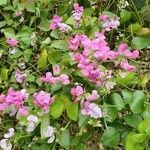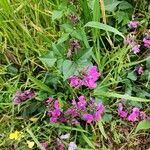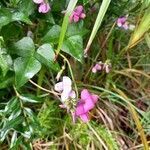Voluble perennial arising from underground, vertical, deeply lenticelled rootstock with dichotomously branching laterals. Shoots spirally twisted, up to 3 m long, weak, glabrescent. Leaves trifoliolate; stipules up to 6 mm long, basifixed, oblong-lanceolate, persistent, clasping but patent when old; petioles up to 5 cm long; leaflets 2-7 cm long, 1-4.5 cm wide, laterals smaller, stipellate, eglandular, paler beneath, glabrescent; terminal leaflet ovate-acuminate, laterals gibbous on lower margin. Petiolules up to 3 mm long. Rhachis 1-2 cm long, puberulent, armed with two persistent acrorhachial stipels. Racemes 5-10(-33)-flowered, axillary, up to 25 cm long, longer than leaves, shortly and densely racemose towards apex, sometimes twisted; pedicels 5-10 mm long, somewhat flattened, becoming purplish with age, armed with small caducous bracteoles near apex; bracts small, green, persistent until flower abscises. Flowers purple, turning pale mauve, 10-15 mm long, reflexed; bracts persistent; calyx campanulate, lobes 5, short and broad, tube twice longer than lobes, 2 horn (upper) lobes rounded, lateral and keel lobes triangular, ciliate. Standard 10-15 cm long and broad; apex emarginate, base auricled, with prominent appendages (callus lobes, callosities) situated low down extending from auricles to apex of claw, raised to form an entrance against which insects can thrust their thoracic region. Wings longer than keel blade, hanging slightly flared, with upper auricles inserted between appendages, pinkish. Keel blades rostrate, apex incurved, purple tipped. Stamens diadelphous, stamens held at two levels. Pistil sessile; ovary linear, with hairs along upper ridge; ovules 4-5; style channelled, bearded along upper inner margin, strongly curved near the base and apex in same direction, the middle part being gently curved in opposite direction; stigma capitate, fringed with hairs. Discoid floral nectary present. Legume 40-60 mm long, 8-10 mm wide, oblong, attenuate at base and apex, tipped with persistent style. Seeds 4-5, subglobose, 3.5-4.5 mm wide; hilum 2.5-3 mm long, black or speckled. Germination hypogeal, epicotyl absent; primordial leaves ovate, base cordate, opposite, petiole up to 1.8 mm long; stipules 2, undivided, oblong-lanceolate, persistent; acrorhachial stipels present. Flowering begins in July, reaches a peak in October then declines rapidly after December.
More
Perennial, twining, herbaceous climber, up to 3.65 m high; becoming woody below, glabrescent. Leaves pinnately trifoliolate. Leaflets ovate-acuminate, 35-40(-50) mm long; lower surface glabrous, except on veins. Inflorescences dense, 3-6-flowered racemes; pubescent peduncles 70-80 mm long. Flowers purple turning pale. Calyx: tube subglobose; 5 short and broad lobes. Petals: standard ± 10 mm long, base with prominent callosities; wings longer than keel, flared. Style recurved at apex, base bent at right angles to ovary, channelled, bearded inner margin; stigma capitate, penicillate. Flowering time July-Nov. Pod ± 50 mm long, attenuate at base and apex; style persistent. Seeds 4-6, subglobose, black-streaked.
Stem moderately hairy, particularly in upper parts, glabrous and woody toward base. Lvs ± glabrous or sparsely hairy; leaflets deltoid to ovate-deltoid, acute to acuminate, entire, 25-55 mm long; stipules ovate-triangular, usually reflexed, (2)-4-7 mm long; stipels lanceolate, 2-5 mm long. Infl. > lvs, c. 5-20-flowered, with many bracteoles; pedicels < fls. Calyx ± glabrous, but teeth ciliate; calyx teeth < tube, broadly ovate-triangular. Corolla white, or lavender and white, or pink to reddish purple, 10-15 mm long; keel curved through 90°. Pod glabrous, boat-shaped and slightly curved, 3-5-seeded, (25)-30-40-(45) mm long; seeds brown, oblong-ellipsoid, c. 4 mm long.
Herbaceous climber from woody base. Leaves pinnately 3-foliolate, leaflets rhombic, glaucous below. Flowers in pedunculate racemes, magenta or pink.



